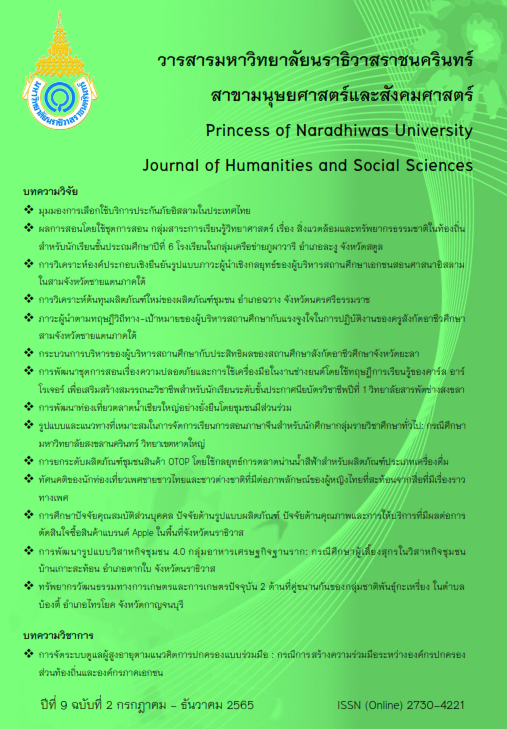Cultural Resources in Agriculture and the Current Agriculture: the Two Parallel Sides of the Karen Ethnic Group in Bongti Bon village, Tumbol Bongti, Amphur Saiyok, Kanchanaburi
Main Article Content
Abstract
The agricultural production system of the Karen ethnic groups in Bongti Bon Village, Tumbol Bongti, Aumphur Sai Yok, Kanchanaburi has two parallel sides. Firstly, the production of upland rice, which is still being produced in a shifting cultivation on the foothills. There is still a story about a variety of beliefs in the resource-rich rice production system of agricultural culture, which the main idea of the rice production is to be kept for family consumption. There is a powerful connection between the rice production system and the culture traditions since the preparation for planting maintenance of production plots until the harvest and after the harvest. These data reflect the traditional agricultural cultural resources of the Karen ethnic groups living in the area that are still bound with the traditional culture of ancestors. Secondly, the other production system that runs parallel to the agricultural production system of the Karen ethnic groups in Bongti Bon village, is Monoculture or chemical agricultural production system. The target of this system is for making money to be enough for daily expenses. In contrast with the first system, the Monoculture or chemical agricultural production system has no cultural connection, but rather focus on making a living. The research shows that the Karen ethnic groups in Bongti Bon village are highly adapted to live in parallel cultures, Thai culture and traditional culture. However, there are a number of problems that cause the culture associated with the rice production of the Karen ethnic groups in Bong Di Bon village will begin to deteriorate and may eventually disappear. This also affects changes in consumption in the family. From the research results, the information can be used to promote the benefits of food security among the Karen ethnic groups, and to create an understanding of food production of the Karen ethnic groups in Thailand in order to reduce conflicts in the matter, the land use for food production of Karen ethnic groups in Thailand.
Article Details

This work is licensed under a Creative Commons Attribution-NonCommercial-NoDerivatives 4.0 International License.
References
กฤษฎา บุญชัย. (2564). ไร่หมุนเวียน สิทธิทางวัฒนธรรมเพื่อความเป็นธรรมทางนิเวศและสังคม. สืบค้นจาก https://www.ldi.or.th/2021/02/25/swidden/
เกศศิริ วงศ์สองชั้น, เกตศินี เพ็งอำไพ, พนิดา สอนสุภาพ, ลลิดา ทองทับ, สุมาลี เอมแย้ม, เสาวลักษณ์
บรรณสาร, และภูริณัฐร์ โชติวรรณ. (2560). การปรับตัวทางวัฒนธรรมในโลกสมัยใหม่ของชาวกะเหรี่ยง หมู่บ้านกะเหรี่ยงน้ำตก ตำบลคลองลานพัฒนา อำเภอคลองลาน จังหวัดกำแพงเพชร. รายงานสืบเนื่องจากการประชุมวิชาการระดับชาติครั้งที่ 4 (หน้า 43-58). กำแพงเพชร: มหาวิทยาลัยราชภัฏกำแพงเพชร.
ขจัดภัย บุรุษพัฒน์. (2540). ชนกลุ่มน้อยสัญชาติพม่า. กรุงเทพฯ: แพร่พิทยา.
ชาญณรงค์ ดวงสะอาด. (2553). การปฏิวัติเขียว แมลงศัตรูพืช และการควบคุมแมลงศัตรูพืชโดยชีววิธี. วารสารเกษตร, 26(3), 269-278.
นัฐวุฒิ สิงห์กุล, และวราภรณ์ มนต์ไตรเวศย์. (2562). พลวัตชุมชนชาติพันธุ์กะเหรี่ยงภาคตะวันตกของไทยระยะที่ 1 พื้นที่ศึกษา จังหวัดสุพรรณบุรี อุทัยธานี และนครสวรรค์. ชุดโครงการศึกษาวิจัยพลวัติของชุมชนชาติพันธุ์เพื่อการสร้างแผนที่วัฒนธรรมมีชีวิต ปีที่ 1 (พ.ศ. 2562 (รายงานวิจัย). กรุงเทพฯ: ศูนย์มานุษยวิทยาสิรินธร (องค์การมหาชน).
ณัฎฐ์ชรัชช์ สาระหงส์, บุญสม ยอดมาลี, และสมชาย ลําดวน. (2561). ศักยภาพทางวัฒนธรรมของชาวปกาเกอะญอ: พลวัตการจัดการท่องเที่ยวทางวัฒนธรรมโดยชุมชน จังหวัดแม่ฮ่องสอน. วารสารวิชาการเครือข่ายบัณฑิตศึกษามหาวิทยาลัยราชภัฏภาคเหนือ, 8(14), 87-102.
ธนากร เที่ยงน้อย. (2563). ระบบการผลิตทางการเกษตรแบบบูติค Boutique Agricultural (ตอนที่ 1).นิตยสารเทคโนโลยีชาวบ้าน, 32(718), 74-75.
ธนากร เที่ยงน้อย, พัฒนา สุขประเสริฐ, และเฉลิมพล จตุพร. (2564). องค์กรชุมชนด้านการส่งเสริมอาชีพเพื่อการพัฒนาอย่างยั่งยืน. วารสารอารยธรรมศึกษา โขง-สาละวิน, 12(1), 48-69.
นพรัตน์ ไชยชนะ, และวีรวัฒน์ อุดมทรัพย์. (2562). วิถีชีวิตและความมั่นคงทางอาหารในมิติวัฒนธรรมของกลุ่มชาติพันธุ์กะเหรี่ยงโปร์ บ้านไร่ป้า ตำบลห้วยเขย่ง อำเภอทองผาภูมิ จังหวัดกาญจนบุรี. วารสารสถาบันวัฒนธรรมและศิลปะ มหาวิทยาลัยศรีนครินทรวิโรฒ, 19(2), 9-19.
บุญช่วย ศรีสวัสดิ์. (2545). ชาวเขาในไทย (พิมพ์ครั้งที่ 2). กรุงเทพฯ: มติชน.
พิสิฐ เจริญวงศ์. (2542). ปาฐกถาศิลป์ พีระศรี ครั้งที่ 4 15 กันยายน 2542 เรื่องการจัดการทรัพยากรศิลปะและวัฒนธรรม. กรุงเทพฯ: พิมพลักษณ์.
รัชกรณ์ อุแสง. (2541). ความเชื่อและประเพณีของชาวกะเหรี่ยงเกี่ยวกับการประกอบอาชีพเกษตร บ้านห้วยหยวก ตำบลแม่ริม อำเภอแม่วาง จังหวัดเชียงใหม่. (วิทยานิพนธ์ปริญญาวิทยาศาสตร์มหาบัณฑิต). มหาวิทยาลัยเชียงใหม่, เชียงใหม่.
สดานุ สุขเกษม. (2562). เรียนรู้จากการซ่อมสร้างชุมชนกะเหรี่ยงบางกลอย. กรุงเทพฯ: สำนักสื่อสารจัดการความรู้และนวัตกรรมชุมชน สถาบันพัฒนาองค์กรชุมชน (องค์การมหาชน).
สุวัฒนา เลี่ยมประวัติ. (2547). ชุมชนภาษาในจังหวัดราชบุรี. วารสารมหาวิทยาลัยศิลปากร, 24(3), 187-211.
สำนักงานสถิติแห่งชาติ. (2565). Statistical tables. สืบค้นจาก http://web.nso.go.th/en/census/poph /data/090913_StatisticalTables_10.pdf
สำนักงานคณะกรรมการส่งเสริมวิทยาศาสตร์ วิจัยและนวัตกรรม (สกสว.). (2564). กลุ่มชาติพันธุ์ในประเทศไทย งานวิจัยและความท้าทาย. กรุงเทพฯ: กระทรวงการอุดมศึกษา วิทยาศาสตร์วิจัยและนวัตกรรม (อว.).
อานันท์ กาญจนพันธุ์ (บก.) (2543). พลวัตของชุมชนในการจัดการทรัพยากร : กระบวนทัศน์และนโยบาย. กรุงเทพฯ: สำนักงานกองทุนสนับสนุนการวิจัย (สกว).
อานันท์ กาญจนพันธุ์. (2549). วัฒนธรรมทางเศรษฐกิจในเศรษฐกิจไร้วัฒนธรรม. กรุงเทพฯ: คบไฟ.
องค์การบริหารส่วนตำบลบ้องตี้ อำเภอไทรโยค จังหวัดกาญจนบุรี. (2561). แผนพัฒนาท้องถิ่น 4 ปี(พ.ศ. 2561-2564). กาญจนบุรี.
องค์ บันจุน. (2560). หลวงพ่ออุตตมะ กองทัพมอญ และกองกำลังกะเหรี่ยง. ศิลปวัฒนธรรม, 38(5),44-55.
Buergin, R. (2015). Contested Rights of Local Communities and Indigenous Peoples in Conflicts over Biocultural Diversity: The case of Karen communities in Thung Yai, a World HeritageSite in Thailand. Modern Asian Studies, 49, 2022 – 2062.
Erni, C., & Nikornuaychai, P. (2015). The lizard on the tree and the Tailor Bird village: 21st Century livelihood challenges among Karen swidden farmers in Thailand. In Chirstian Erni (ed). Shifting Cultivation, Livelihood and Food Security, New and Old Challenges for Indigenous Peoples in Asia. Bangkok: FAO, IWGIA, AIPP.
Hayami, Y. (1993). To be Karen and to be cool: Community, morality and identity among Sgaw Karen in Northern Thailand. Cahiers des Sciences Humines, 29(44), 747-762.
Marshall, H. I. (1997). The Karen People of Burma A Study in Anthopology and Ethnology. Thailand: White Lotus Press.
Phillips, A. (2018). West-Central Thailand Pwo Karen Phonology. Journal of the Southeast Asian Linguistics Society, 11(1), 47-62.
Punchay, K., Inta, A., Tiansawat, P., Balslev, H., & Wangpakapattanawong, P. (2020). Traditional knowledge of wild food plants of Thai Karen and Lawa (Thailand). Genetic Resources and Crop Evolution, 67(5), 1277–1299.
Sukkasame, S. (2021). Livelihoods and Dwelling Security: The Challenges of Indigenous Karen People. Journal of Community Development Research (Humanities and Social Sciences),14(4), 1-13.
Sitthikriengkrai, M., & Porath, N. (2019). Environmental Illness at Klity Creek (Thailand): A Karen Village’s Quest for Justice. In Behera, M. (ed). Shifting Perspectives in Tribal Studies.Singapore: Springer.
Tachakitkachorn, T., Attavanich, M., Thawanaphong, C., Saikhun, P., & Ngamsiriudom, T. (2021).Sustainable Engagement with Indigenous Settlements in Prohibited Areas: A Case Study of Karen Tribe Villagers in the KaengKrachan Forest Complex, Thailand. Nakhara: Journal of Environmental Design and Planning 20(2), 1-14.
Yamabhai, J., Knoop, R., & Cusripituck, P. (2021). Participatory Engagement for Sustainable Innovation in Karen Communities. Austrian Journal of South-East Asian Studies, 14(2), 195–212.


